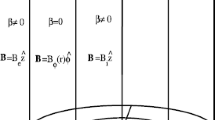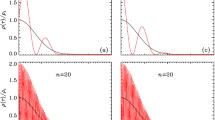Abstract
We consider a model of a coronal loop that is a cylindrical magnetic tube with two surface electric currents. Its principal sausage mode has no cut-off in the long-wavelength limit. For typical coronal conditions, the period of the mode is between one and a few minutes. The sausage mode of flaring loops could cause long-period pulsations observed in microwave and hard X-ray ranges. There are other examples of coronal oscillations: long-period pulsations of active-region quiet loops in the soft X-ray emission are observed. We assume that these can also be caused by sausage waves. The question arises of how the sausage waves are generated in quiet loops. We assume that they can be generated by torsional oscillations. This process can be described in the framework of the nonlinear three-wave interaction formalism. The periods of interacting torsional waves are similar to the periods of torsional oscillations observed in the solar atmosphere. The timescale of the sausage-wave excitation is not much longer than the periods of interacting waves, so that the sausage wave is excited before torsional waves are damped.



Similar content being viewed by others
References
Alfvén, H., Carlqvist, P.: 1967, Solar Phys. 1, 220. ADS . DOI .
Antolin, P., Shibata, K., Kudoh, T., Shiota, D., Brooks, D.: 2008, Astrophys. J. 688, 669. ADS . DOI .
Aschwanden, M.J., Nakariakov, V.M., Melnikov, V.F.: 2004, Astrophys. J. 600, 458. ADS . DOI .
Aurass, H., Mann, G.: 1987, Solar Phys. 112, 359. ADS . DOI .
Banerjee, D., Gupta, G.R., Teriaca, L.: 2011, Space Sci. Rev. 158, 267. ADS . DOI .
Banerjee, D., Pérez-Suárez, D., Doyle, J.G.: 2009, Astron. Astrophys. 501, L15. ADS . DOI .
Cally, P., Hansen, S.: 2011, Astrophys. J. 738, 119. ADS . DOI .
Chin, Y.-C., Wentzel, D.G.: 1972, Astrophys. Space Sci. 16, 465. ADS . DOI .
Copil, P., Voitenko, Y., Goossens, M.: 2008, Astron. Astrophys. 478, 921. ADS . DOI .
De Moortel, I., Nakariakov, V.M.: 2012, Phil. Trans. Roy. Soc. London A 370, 3193.
De Pontieu, B., McIntosh, S.W., Carlsson, M., Hansteen, V.H., Tarbell, T.D., Schrijver, C.J., Title, A.M., Shine, R.A., Tsuneta, S., Katsukawa, Y., Ichimoto, K., Suematsu, Y., Shimizu, T., Nagata, S.: 2007, Science 318, 1574. ADS . DOI .
De Pontieu, B., Carlsson, M., van der Voort, L.H.M.R., Rutten, R.J., Hansteen, V.H., Watanabe, H.: 2012, Astrophys. J. Lett. 752, L12. ADS . DOI .
Edwin, P.M., Roberts, B.: 1983, Solar Phys. 88, 179. ADS . DOI .
Erdélyi, R., Fedun, V.: 2007, Science 318, 1572. ADS . DOI .
Fedun, V., Verth, G., Jess, D.B., Erdélyi, R.: 2011, Astrophys. J. Lett. 740, L46. ADS . DOI .
Goossens, M., Terradas, J., Andries, J., Arregui, I., Ballester, J.L.: 2009, Astron. Astrophys. 503, 213. ADS . DOI .
Goossens, M., Terradas, J., Andries, J., Arregui, I., Ballester, J.L.: 2012, Astrophys. J. 753, 111. ADS . DOI .
Gupta, G.R., Banerjee, D., Teriaca, L., Imada, S., Solanki, S.: 2010, Astrophys. J. 718, 11. ADS . DOI .
Hansen, S., Cally, P.: 2012, Astrophys. J. 751, 31. ADS . DOI .
Hollweg, J.V., Kaghashvili, E. Kh.: 2012, Astrophys. J. 744, 114. ADS . DOI .
Jess, D.B., Mathioudakis, M., Erdélyi, R., Crockett, P.J., Keenan, F.P., Christian, D.J.: 2009, Science 323, 1582. ADS . DOI .
Karami, K., Bahari, K.: 2011, Astrophys. Space Sci. 333, 463. ADS . DOI .
Khongorova, O.V., Mikhalyaev, B.B., Ruderman, M.S.: 2012, Solar Phys. 280, 153. ADS . DOI .
Kim, S., Nakariakov, V.M., Shibasaki, K.: 2012, Astrophys. J. Lett. 756, L36. ADS . DOI .
Kupriyanova, E.G., Melnikov, V.F., Nakariakov, V.M., Shibasaki, K.: 2010, Solar Phys. 267, 329. ADS . DOI .
McKenzie, D.E., Mullan, D.J.: 1997, Solar Phys. 176, 127. ADS . DOI .
Mikhalyaev, B.B.: 2005, Pis’ma Astron. Zh. 31(6), 456 (in Russian). ADS . DOI .
Mikhalyaev, B.B., Khongorova, O.V.: 2012, Pis’ma Astron. Zh. 38(10), 746 (in Russian). ADS . DOI .
Moll, R., Cameron, R.H., Schussler, M.: 2012, Astron. Astrophys. 541, A68. ADS . DOI .
Moriyasu, S., Kudoh, T., Yokoyama, T., Shibata, K.: 2004, Astrophys. J. Lett. 601, L107. ADS . DOI .
Morton, R.J., Verth, G., Fedun, V., Shelyag, S., Erdélyi, R.: 2013, Astrophys. J. 768, 17. ADS . DOI .
Nakariakov, V.M., Melnikov, V.F.: 2009, Space Sci. Rev. 149, 119. ADS . DOI .
Okamoto, T.J., De Pontieu, B.: 2011, Astrophys. J. Lett. 736, L24. ADS . DOI .
Phillips, O.M.: 1974, In: Leibovich, S., Seebass, R. (eds.) Nonlinear Waves, Cornell University Press, Ithaca, 197.
Ruderman, M.S., Berghmans, D., Goossens, M., Poedts, S.: 1997, Astron. Astrophys. 320, 305. ADS .
Sagdeev, R.Z., Galeev, A.A.: 1969, Nonlinear Plasma Theory, Benjamin Press, New York.
Shelyag, S., Fedun, V., Keenan, F.P., Erdélyi, R., Mathioudakis, M.: 2011, Ann. Geophys. 29, 883. ADS . DOI .
Shelyag, S., Cally, P.S., Reid, A., Mathioudakis, M.: 2013, Astrophys. J. Lett. 776, L4. ADS . DOI .
Soler, R., Carbonell, M., Ballester, J.L., Terradas, J.: 2013a, Astrophys. J. 767, 171. ADS . DOI .
Soler, R., Díaz, A.J., Ballester, J.L., Goossens, M.: 2013b, Astron. Astrophys. 551, A86. ADS . DOI .
Tian, H., McIntosh, S.W., Wang, T., Ofman, L., De Pontieu, B., Innes, D.E., Peter, H.: 2012, Astrophys. J. 759, 144. ADS . DOI .
Tomczyk, S., McIntosh, S.W.: 2009, Astrophys. J. 697, 1384. ADS . DOI .
Tomczyk, S., McIntosh, S.W., Keil, S.L., Judge, P.G., Schad, T., Seeley, D.H., Edmondson, J.: 2007, Science 317, 1192. ADS . DOI .
Trottet, G., Pick, M., Heyvaerts, J.: 1979, Astron. Astrophys. 79, 164. ADS .
Uchida, Y., Kaburaki, O.: 1974, Solar Phys. 35, 451. ADS . DOI .
Verth, G., Erdélyi, R., Goossens, M.: 2010, Astrophys. J. 714, 1637. ADS . DOI .
Wang, M., Xie, R.X.: 1997, Solar Phys. 176, 171. ADS . DOI .
Wedemeyer-Bohm, S., Scullion, E., Steiner, O., Rouppe van der Voort, L., de La Cruz Rodriguez, J., Fedun, V., Erdélyi, R.: 2012, Nature 486, 505. ADS . DOI .
Wilhelmsson, H., Weiland, J.: 1977, Coherent Nonlinear Interaction of Waves in Plasmas, Pergamon, New York.
Zaitsev, V.V., Stepanov, A.V.: 1975, Issled. Geomagn. Aeron. Fiz. Soln. 37, 3 (in Russian).
Zaitsev, V.V., Stepanov, A.V.: 1983, Solar Phys. 88, 297. ADS . DOI .
Zaqarashvili, T.V.: 2003, Astron. Astrophys. 399, L15. ADS . DOI .
Zaqarashvili, T.V., Erdélyi, R.: 2009, Space Sci. Rev. 149, 355. ADS . DOI .
Acknowledgements
This article was supported by the Russian Foundation for Basic Researches (grant 14-02-00676a). The authors thank the referee for a number of useful comments that significantly improved the quality of the article.
Author information
Authors and Affiliations
Corresponding author
Appendix
Appendix
The dispersion equation for the sausage mode has the form
Coefficients in the nonlinear terms (41) – (42) are
The interaction coefficients in Equations (45) – (47) are
Rights and permissions
About this article
Cite this article
Mikhalyaev, B.B., Bembitov, D.B. Nonlinear Resonant Excitation of Fast Sausage Waves in Current-Carrying Coronal Loops. Sol Phys 289, 4069–4083 (2014). https://doi.org/10.1007/s11207-014-0566-y
Received:
Accepted:
Published:
Issue Date:
DOI: https://doi.org/10.1007/s11207-014-0566-y




